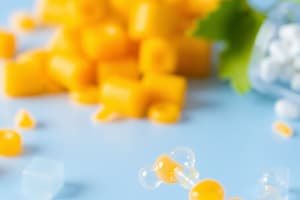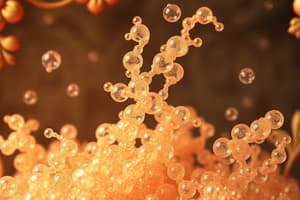Podcast
Questions and Answers
What is the maximum number of monosaccharide units that oligosaccharides can contain?
What is the maximum number of monosaccharide units that oligosaccharides can contain?
- 2-10 (correct)
- 11-20
- More than 20
- 1
What are disaccharides?
What are disaccharides?
Disaccharides are carbohydrates that contain 2 monosaccharide units.
Table sugar (sucrose) is a reducing sugar.
Table sugar (sucrose) is a reducing sugar.
False (B)
What do disaccharides produce upon hydrolysis?
What do disaccharides produce upon hydrolysis?
Oligosaccharides are associated with proteins and lipids for ______ functions.
Oligosaccharides are associated with proteins and lipids for ______ functions.
What are the two types of biochemical substances mentioned?
What are the two types of biochemical substances mentioned?
Flashcards are hidden until you start studying
Study Notes
Carbohydrates in Biochemistry
- Carbohydrates are essential biochemical substances made up of carbon, hydrogen, and oxygen.
- They are categorized based on the number of monosaccharide units:
- Monosaccharides (single units)
- Oligosaccharides (2-10 units)
- Polysaccharides (more than 10 units)
Oligosaccharides
- Composed of 2 to 10 monosaccharide units linked by covalent bonds.
- Commonly found in both plants and the human body, serving structural and regulatory roles.
- Can be further classified:
- Disaccharides: Contain two monosaccharides; examples include sucrose (glucose + fructose) and lactose (glucose + galactose).
- Often water-soluble and crystalline in nature.
Hydrolysis of Carbohydrates
- Disaccharides can undergo hydrolysis, breaking down into their monosaccharide components.
- Hydrolysis plays a crucial role in the digestion and absorption of carbohydrates in the human body.
Non-reducing Sugars
- Some disaccharides, like sucrose, are categorized as non-reducing sugars, which do not have a free aldehyde or ketone group.
Bioinorganic and Bioorganic Substances
- Bioinorganic substances: Include water and inorganic salts, vital for biological functions.
- Bioorganic substances: Larger biomolecules including carbohydrates, proteins, and lipids, crucial for life forms.
Studying That Suits You
Use AI to generate personalized quizzes and flashcards to suit your learning preferences.




